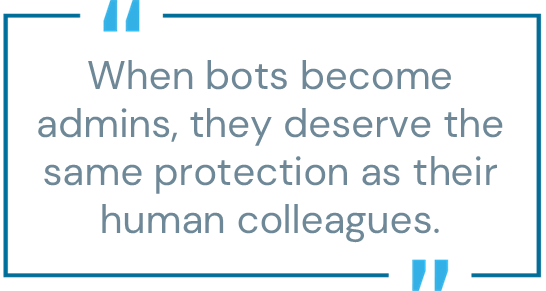
From resetting passwords and approving workflows to pulling HR data and orchestrating cloud infrastructure, AI agents now perform tasks that previously required a human with privileged access. AI has moved beyond the realm of passive chatbots into autonomous, persistent operations, performing work on behalf of an individual or entity.
Like it or not, that makes AI agents a new part of your workforce.
They hold credentials, trigger workflows, and make their own decisions. And they’re doing it all with increasing scope, speed, and influence.
As AI advances, AI agents will behave more like humans—yet they’ll need to authenticate like machines. This means we must revisit how we define and defend privileged access.

The governance gap: securing privileged AI agents
It’s something we talk about a lot: AI agents are privileged users, but most teams aren’t governing them like they would humans—or even service accounts. In fact, according to the 2025 Identity Security Landscape, 68% of organizations report that they do not have security controls in place for AI and large language models (LLMs), yet 82% know their company’s use of AI creates sensitive access risks.
That disconnect is alarming because AI agents rely on credentials like:
- Certificates: Often tied to back-end access and now subjected to 47-day renewals under CA/B Forum mandates.
- API tokens: Long-lived and frequently over-permissioned.
- Secrets: Static, hardcoded in scripts, or stored without centralized control.
When these credentials expire, go unmonitored, or are compromised, the results include silent failures, operational outages, and an increased attack surface—especially in services that support end users or public-facing workflows.
Because AI agents often interact with sensitive data, citizen services, financial systems, or production environments, the blast radius from even a single misstep can be massive.
We’ve built decades of controls around human access. The same discipline must be applied to agentic AI.
Four essential steps to help secure AI agents as privileged identities
To meet this moment, your organization must evolve its identity security strategy and treat AI agents as part of the privileged ecosystem. The reassuring part is that you won’t be starting from scratch. You’ll be extending controls you’ve already come to trust to a new class of digital actor.
Think of it as expanding your existing toolkit to cover a new set of challenges. Here are four steps that can help get started:
1. Apply privileged access management (PAM) to AI agents
Treat bots and autonomous agents like privileged users:
- Enforce least privilege.
- Monitor actions.
- Restrict access to high-risk systems.
2. Govern credentials
Extend secrets management and certificate lifecycle automation to all agentic AI workflows:
- Store credentials centrally.
- Rotate tokens and secrets regularly.
- Automate renewals of machine identities to prevent outages or security incidents.
3. Embrace identity convergence
Inventory all AI agents, assign ownership, and clearly understand what each one is doing—and on whose behalf.
4. Extend endpoint privilege management (EPM) where needed
Apply EPM controls to local agents or AI tools running on endpoints—restrict their ability to escalate privileges, access file systems, or pivot across the network.
Thirty-day action plan for security leaders: Governing AI agents
To move from strategy to action, security leaders should focus on immediate, practical steps that lay the groundwork for robust AI agent governance. Here’s a week-by-week plan to help you get started over the next 30 days:
- Week 1: Inventory AI agents across your environment. Identify the systems they interact with and the credentials they use.
- Week 2: Classify each agent by privilege level. Prioritize those with access to heavily regulated data or live production systems.
- Week 3: Integrate certificates, secrets, and tokens into automated lifecycle and secrets management platforms.
- Week 4: Assign ownership to ensure someone is accountable for monitoring and managing every AI agent’s identity and access.
Expanding identity risks: Is your security strategy keeping up?
As the boundaries of digital identity continue to blur, security approaches must evolve to match our new reality. AI agents are now woven into the operational fabric of mission-critical systems, and their credentials and permissions increasingly hold the keys to sensitive assets.
Forward-thinking organizations are reevaluating their risk models and implementing robust controls, recognizing that every AI agent represents a potential vector for compromise or disruption if not properly governed. This tremendous shift demands proactive strategies that anticipate how machine identities will proliferate and interact, ensuring oversight and agility as technology outpaces old paradigms.
By treating AI agents as privileged identities and extending PAM, secrets management, and machine identity governance to cover them, you can better prevent outages, reduce attack surfaces, meet evolving compliance mandates, and position your business for what comes next.
Because when bots become admins, they deserve the same protection as their human colleagues.
Nick Curcuru is a director in the CyberArk Trust Office.





















